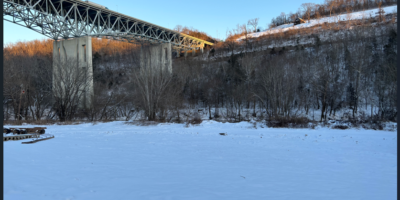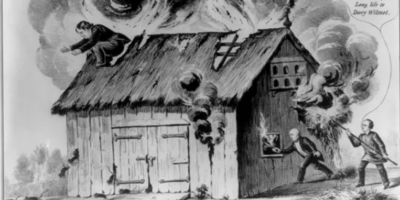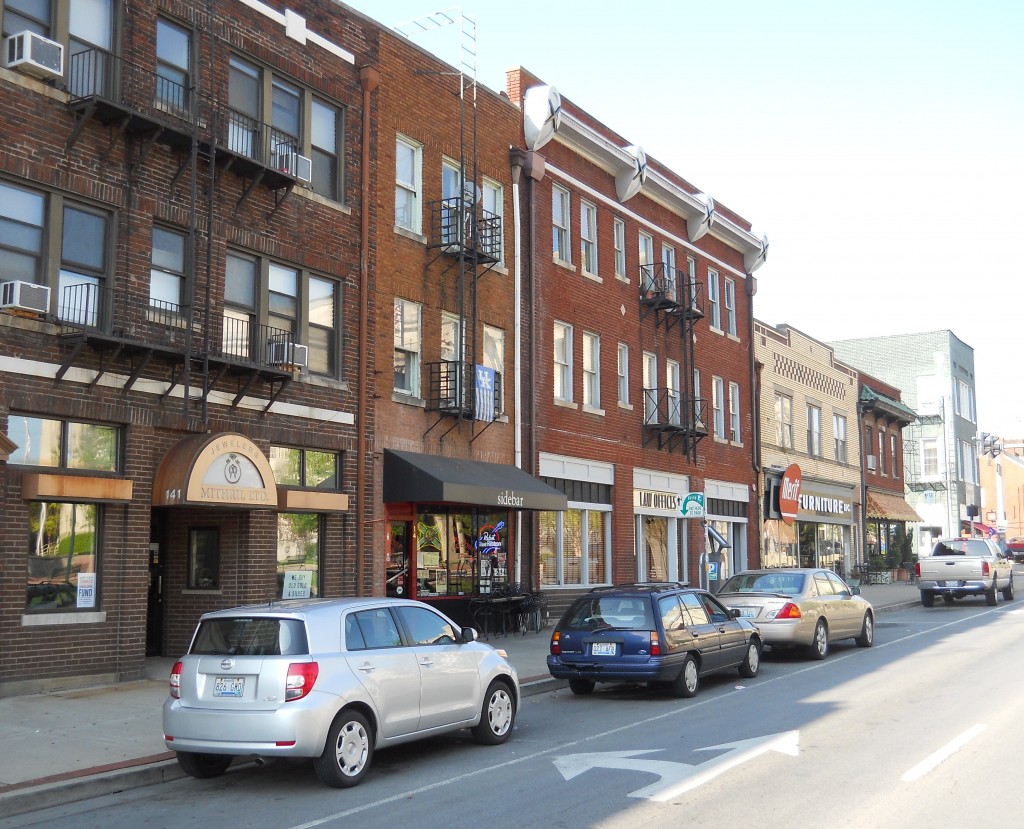By David Shattuck
Editor’s note: David’s previous two columns demonstrated that converting Lexington’s downtown streets to two-way traffic would result in unacceptable congestion at peak hours. Currently, city leadership is once-again expending public capital to study two-way conversion as a means to improve the city.
Conversion proponents argue that slower traffic makes streets more “walkable,” thereby enhancing retail potential, and that retailers shun locating on one-way streets. Slower traffic means fewer accidents, and is safer for pedestrians, they reason. This column dispels these myths.
One would expect that conversion proponents would have evidence supporting their claims. The Lexington Downtown Development Authority (LDDA), an entity that was created in large part to make conversion happen, offers none. Remarkably, as the LDDA wrote me last November, it “has conducted no research and has no information regarding the benefits and costs of converting Lexington’s downtown streets to two-way traffic.”
It doesn’t take a degree in urban planning to know that increased congestion is not beneficial for downtown. Here are some reasons why.
- “I don’t think you bring more life to city centers by increasing the congestion and accident hazards,” says Paul Box, a traffic engineer interviewed by the Wall Street Journal in 1996.
- “[T]wo-way streets are likely to contribute to downtown decay as they reduce the capacity of streets to move traffic into and through downtowns,” writes Randal O’Toole, an economist with the American Dream Coalition, a group dedicated to promoting auto travel and the right to live in the suburbs.
- Conversion “would ensure that downtown is choked off and would destroy downtown as a potential urban center,” Lexington attorney Gordon Moss writes in a 2004 letter to the Herald-Leader.
- “Parking is the primary reason (for businesses) to not be downtown,” explains Bill Harman in the March 9, 2007 edition of Business Lexington.
- “Drivers wanting to shop downtown found it very difficult to find a convenient parking space,” Tom Radden Sr. explains in a letter to the Herald-Leader last January.
Those most familiar with our downtown know that one-way traffic is no serious impediment to retail success. As the above urban observers note, it is the perception that downtown is congested that has the potential to keep many folks away, just as the perception that parking is scarce deters many from visiting downtown now.
False premise
As Michael Cunneen, an Oregon traffic engineer who has studied the topic for over a decade, explains, sreet conversion is predicated on a false premise: “Popular places are congested, so if we can congest an unpopular place it will have the ambiance of popularity even if our actions actually reduce the number of people able to get to the area.”
Conversion proponents commit the fallacy of thinking that the appearance of busyness brought about by slowing traffic will spawn retail activity; in fact, it’s the other way around: give folks a reason to travel—a farmers market, a movie, fine dining, and they will make their way downtown.
Consider, for instance, a couple of downtown’s two-way and one way streets. Third and Fourth Streets were converted to two-way traffic back in 2000; yet, this move has resulted in no significant business or residential activity. Conversely, businesses have sprouted on North Limestone, a one-way street, between Short and Third Streets, and on Short Street between Broadway and Limestone. Limestone is conducive to retail and residential activity, as is part of Main Street, whereas Vine Street and Third and Fourth are not: Vine is dominated by banks and LexTran and Third and Fourth by Transylvania. Clearly, then, two-way traffic is not a precondition for a successful downtown.
Finally, while it certainly helps, pedestrian traffic does not ensure retail success. Exhibit A is the UK basketball museum. Located next-door to Rupp Arena, which generates significant pedestrian traffic (much of which is headed to/from a ball game), the museum has struggled to remain solvent. Exhibit B is UK itself, which generates significant pedestrian student/faculty/staff traffic; yet prime real estate near campus has remained vacant for significant periods for going on two decades now.
Since roads were built to move cars and since we’re not building more roads but certainly getting more cars, and given that retail success depends on so many variables other than traffic patterns, perhaps its best to let our roads function as intended: to move traffic.
Way-finding
According to the 2007 Lexington Traffic Study, “The reasoning behind the [two-way] recommendation is that one-way streets negatively impact businesses and tourism because the present configuration creates circuitous travel and causes confusion among out-of-town visitors.”
Street conversion was first proposed in the early 1990s, and became fashionable in urban planning circles by the late 1990s. At that time, way-finding was surely more of a concern than it is now, with most cars and mobile phones containing GPS capability.
More important, if a place is worth finding, the tourist will find it. If a retailer is counting on two-way traffic for exposure in this era of internet, GPS, Groupon and the like, is this a retailer who is likely to succeed in the first place? In any event, if it is too inconvenient to access, because of traffic congestion, a visitor may well choose to not make the trip. So whatever benefit conversion might offer in terms of way-finding may well be offset by the congestion that makes accessing downtown not worth the while.
One way streets are safer
Although two-way proponents predict that two-way traffic is safer for pedestrians, I am reminded of the saying “you are entitled to your opinion, but not the facts.” Because, while it may seem counterintuitive since cars travel more slowly in two-way traffic, all of the evidence suggests one way streets are safer in terms of both pedestrian and vehicle accidents. Tampa transportation director Elton Smith notes that “pedestrians are more comfortable crossing one-way streets.” A comprehensive study of pedestrian accidents found one-way streets “the most effective counter-measure” to pedestrian accidents. Michael Cunneen, an Oregon traffic engineer, contacted me after reading a piece the Herald-Leader published last December. Analyzing data from Portland, New York City and Albuquerque, he concludes that one way streets are measurably safer for pedestrians than two way streets.
In addition, “two-way streets tend to experience more traffic accidents because of the higher number of conflicting movements,” according to RKG Associates, who performed a traffic analysis for the city of Bowling Green. Indeed, accidents increased by 37% in Denver on streets converted to two-way, and in Indianapolis accidents increased 33%.
One need look no further than Cincinnati for solid data that two-way streets are safer. The City’s 2003 study concluded: “The safety benefits for pedestrians in this study, as found in several other studies, indicate that pedestrian safety in particular is enhanced by one-way flow. When [Vine Street] was originally made one-way in 1975, the pedestrian accident rate declined by over 21%. In contrast, when it was changed in 1999 back to two-way, the pedestrian accident rate increased by 103%.” In addition, conversion “resulted in a massive increase in accidents with the overall traffic accident rate going up by 116%.”
A study released by the John Locke Foundation in November 2006 concluded: “[O]ne way streets are safer for both drivers and pedestrians. One study . . . found that converting two-way streets to one-way caused a 38% decrease in accidents….Two way streets produced 163% more pedestrian accidents in Sacramento, and 100% more pedestrian accidents in Portland and Hollywood, Florida.”
Air pollution
In 2008 the Brookings Institute ranked Lexington as having the worst carbon footprint among the 100 cities studied. The increased congestion conversion causes would significantly exacerbate Lexington’s pollution problems. Planners in Austin estimate that converting several one-way streets to two-way traffic would increase traffic delays by 23% and increase air pollution levels by 10 to 13%. The Lexington Traffic Study confirms that “higher vehicle emission levels (air pollution) can be expected as a result of the increased congestion” conversion would necessitate. (Indeed, $19,000 of the $100,000 spent on the study came from a federal Air Quality planning grant).
Emergency vehicles
“Traffic calming” refers to measures designed to slow vehicle traffic; two-way street conversion is the most severe of all such measures, given that conversion effectively cuts lane capacity in half. One needn’t be an ambulance driver to realize that emergency response times will be substantially slower on two-way streets. Studies in Boulder and Austin show that 85 heart attack victims will die prematurely before 1 pedestrian death is prevented through traffic calming. Accordingly, emergency response professionals are adamant in their opposition to conversion.
Unproven experiment
Perhaps the most important question one can ask when deciding whether to implement an idea is this: has it ever worked anywhere else? Two-way street conversion fails this test miserably. For while the issue has been tossed around and studied by many cities, in the decade that I’ve studied the matter I have not found a city with streets comparable to Lexington’s where conversion has made a difference. Colorado Springs commissioned a study of conversions in “similar sized cities” in early 2007. The study concluded that, at best, the economic benefits are mixed: “Recent studies vary widely in their findings and often contradict one another.”
Cincinnati is one of ten cities surveyed in that study; it converted Vine Street in 1999 as part of a major revitalization effort. The study found that the Cincinnati conversion “didn’t accomplish much” and “did not result in the revitalization expected in the area.” Although traffic speeds decreased, accidents increased. The city reported: “We are considering converting the street back to a one-way because the traffic flow on that street is important for travel between uptown and downtown.”
Tucson, Arizona had decided in 2004 to convert a major one-way pair running east-west through downtown. In February 2007, however, the city council voted unanimously to keep these streets as a one-way pair. The Cincinnati and Tucson examples are particularly instructive for Lexington, since Main/Vine and High/Maxwell are the only major streets running east-west downtown; alternative routes are not available. As Richard Deneger wrote the Herald-Leader in February 2006: “Returning Vine and High streets to two-way streets would be a huge mistake as they represent the only realistic east-west corridor through the city.”
It is no wonder then, that economist Randal O’Toole concludes: “By almost any measurable criteria—safety, pollution, congestion, and effects on most local businesses—one-way streets are superior to two-way.” Although Lexington’s developers and planners refuse to acknowledge this fact, we can only hope that public participation will convince the Urban County Council of this truth.





Alan Isaacs
I lived in Lexington in the 60’s when all the streets were 2 way. Population 50k — 60k. Traffic was horrible. Driving through town was very difficult. Now population is 400k. Imagine Upper St and Short St. and High St. all 2 way: Madness. Put the idea to a vote of the people. Who are these people that make decisions like this without consulting the people?
David Shattuck
Thanks for the comments. Dan, you busted me on Randall O’Toole. I’m sorry to have quoted him as well because it wasn’t necessary: the evidence demonstrates the truth of the quoted statement. Conversion proponents, on the other hand, rarely bother to support their claims with any evidence. And for over a decade now they have insisted that 2-way street conversion is essential, yet can point to no city where conversion has made a difference. I have much more to say on the subject and am grateful to NOC for providing this forum for discussing it.
Danny Mayer
I don’t know. On reflection, I like its inclusion. One-way/Two-way has a lot of critics–none of whom are acknowledged in the city’s one-way/2-way debates. It just adds to the voices.
Dan
I have somewhat mixed feelings about the street conversion idea. I live downtown and as much as I hate to admit it, the one way streets can be confusing and difficult to navigate. As much as I think they are a bunch of wimps, I do hear enough people that live in the suburbs complaining about how difficult it is to get around down town, and I have to grudgingly admit that they might have a point.
On the other hand, your points about moving a greater volume of traffic, safety, and less pollution are pretty convincing. As a cyclist I do feel safer on one way streets since you don’t have to worry about oncoming traffic.
If the benefits are mixed at best, it probably isn’t worth the trouble and expense of fooling with it. There are other more important problems for the city to deal with.
I am sorry to see you quote Randal O’Toole in your article. That guy has the reputation of being a pro suburban sprawl hack.
Danny Mayer
My own sense, Dan, is that there are benefits either way (though environmentally, 2-ways seem to be worse, and as a downtown driver, I don’t want more traffic, I want less). I am distraught, though, when our mayor states that converting to 2-way is a top priority for his administration. I recall an article a couple months ago where he listed it along with one other priority, I think it was Rupp, that needed to be done urgently. I’m thinking, really? This is a top priority? To expend money and time on something that, at best, is a break-even proposition, and from what David’s been reporting, is worse than that.
I was thinking the same thing about O’Toole, but figured I can agree with his particular observation without buying his ideology. I equate it to how I feel about Ron Paul (NOT Rand). I agree with Ron Paul that the U.S. needs to quit its imperial wars, but I’m not ever going to vote for him.
Chris Harn
How about we just add several barricades and make us all walk.